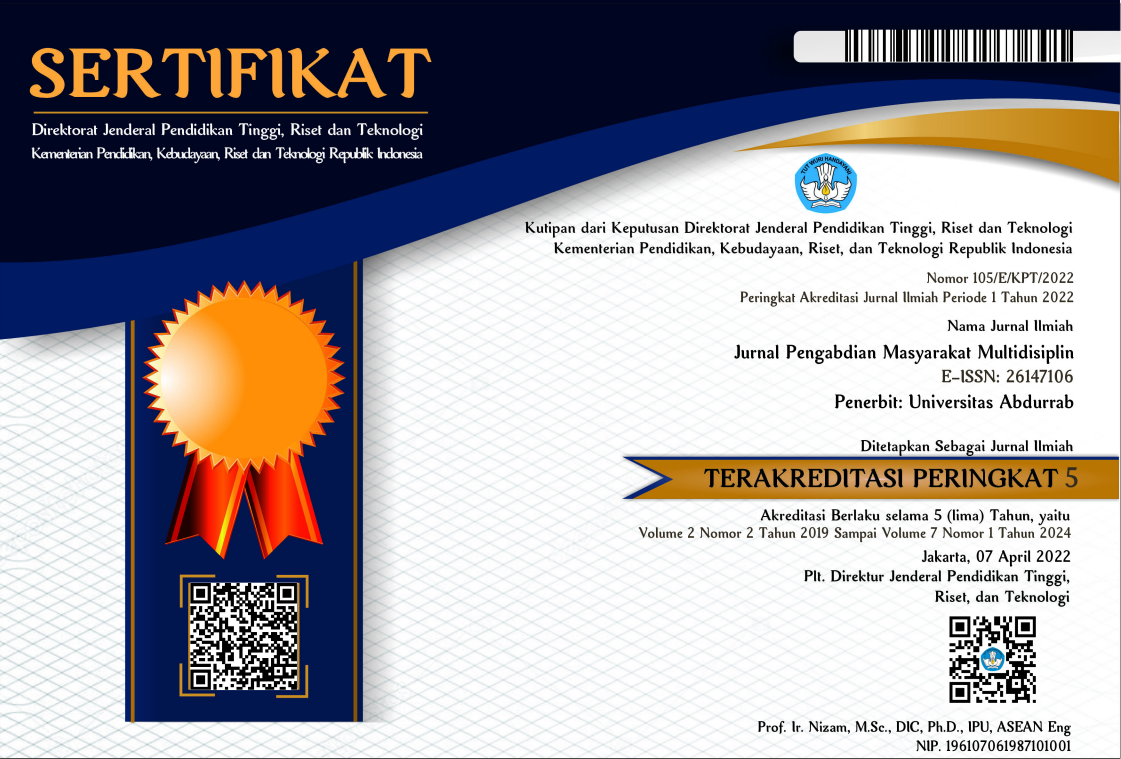PENINGKATAN PENGETAHUAN TENTANG TANAMAN HERBAL TOGA SEBAGAI TERAPI GASTRITIS SISWA SMK IBRAHIMY 1 P2S3 SITUBONDO
INCREASING KNOWLEDGE ABOUT THE TOGA HERBAL PLANT AS A THERAPY FOR GASTRITIS FOR STUDENTS OF IBRAHIMY 1 P2S3 SITUBONDO VOCATIONAL SCHOOL
Abstract
Family Medicinal Plants (TOGA) are nutritious plants planted in yards and fields and managed by families. The types of plants grown fulfill the family's need for traditional medicines that can be made by themselves. The medicinal plants chosen are usually plants that can be used for first aid. The presence of medicinal plants in the home environment is very important, especially for families who do not have easy access to medical services such as clinics, health centers or hospitals. Each family can cultivate medicinal plants independently and use them so that the principle of independence in family medicine will be realized. The method used is counseling, distributing leaflets, asking questions and distributing questionnaires. The aim of the activity is to increase knowledge regarding herbal plants used for gastritis therapy, the importance of maintaining health as a prophylaxis, especially for gastritis which can cause other diseases and cultivating herbal plants. The results obtained were that the majority of respondents were 18 years old at 27.8%, the respondents' education was class After delivering the material the results showed that 90.28% knew TOGA. The usefulness of the activity for participants was 94.44%.
References
S. Adawiyah, C. Noor, and D. Intannia, “Hubungan Persepsi Terhadap Iklan Obat Laksatif Di Televisi Dengan Perilaku Swamedikasi Masyarakat Di Kelurahan Sungai Besar Kecamatan Banjarbaru Selatan,” J. Farm. Malahayati, vol. 4, no. 01, pp. 9–15, 2021, [Online]. Available: https://media.neliti.com/media/publications/269067-hubungan-persepsi-terhadap-iklan-obat-la-d106ad5a.pdf.
W. M. Sidoretno and I. Oktaviani, “Edukasi Bahaya Bahan Kimia Obat Yang Terdapat Didalam Obat Tradisional,” J. Pengabdi. Masy. Multidisiplin Univ. Abdurrab, vol. 1, no. 2, pp. 36–42, 2020, doi: 10.36341/jpm.v1i2.453.
T. Krisna and Herdiyanto, “Konsep Sehat Dan Sakit Pada Individu Dengan Urolithiasis (Kencing Batu) Di Kabupaten Klungkung, Bali,” J. Psikol. Udayana, vol. 4, no. 2, p. 263, 2020, [Online]. Available: https://doi.org/10.24843/jpu.2017.v04.i02.p04.
I. D. Sari, Y. Yuniar, S. Siahaan, R. Riswati, and M. Syaripuddin, “Tradisi Masyarakat dalam Penanaman dan Pemanfaatan Tumbuhan Obat Lekat di Pekarangan,” J. Kefarmasian Indones., vol. 5, no. 2, pp. 123–132, 2022, doi: 10.22435/jki.v5i2.4407.123-132.
C. M. Uritu et al., “Medicinal plants of the family Lamiaceae in pain therapy: A review,” Pain Res. Manag., vol. 18, no. 8, p. 44, 2023, doi: 10.1155/2018/7801543.
A. Savitri, Tanaman Ajaib! Basi Penyakit dengan TOGA (Tanaman Obat Keluarga), I. Depok: Bibit Publisher, 2020.
L. Tuslinah, M. N. Al Anshari, I. N. Asopari, C. Syundari, and N. Sauqi, “Penyuluhan Obat Generik, Obat Yang Terjangkau Dan Efektif Untuk Perawatan Kesehatan Masyarakat,” J. Pengabdi. Masy. Multidisiplin, vol. 7, no. 1, pp. 47–51, 2023, doi: 10.36341/jpm.v7i1.3627.
N. Qamariah, R. Handayani, and S. Novaryatiin, “Peningkatan Pengetahuan dan Keterampilan Ibu Rumah Tangga dalam Pengolahan Tanaman Obat Keluarga (TOGA) sebagai Ramuan Obat Tradisional,” PengabdianMu J. Ilm. Pengabdi. Kpd. Masy., vol. 4, no. 1, pp. 50–54, 2019, doi: 10.33084/pengabdianmu.v4i1.692.
K. Kim, K. P. Lee, S. Beak, S. Park, J. Kim, and S. H. Ahn, “Feasibility of mixed herbal medicine for improving gastric function in an alcohol-induced gastritis model,” Phys. Act. Nutr., vol. 27, no. 1, pp. 1–8, 2023, doi: 10.20463/pan.2023.0001.
S. Juariah, “Pemeriksaan, Pengobatan, Dan Penyuluhan Kebersihan Diri Untuk Mencegah Dan Mengobati Kecacingan Pada Anak Usia Sekolah Guna Meningkatkan Konsentrasi Belajar Pada Anak,” J. Pengabdi. Masy. Multidisiplin, vol. 1, no. 1, pp. 32–36, 2020, doi: 10.36341/jpm.v1i1.393.
I. Batubara and M. E. Prastya, “Potensi Tanaman Rempah dan Obat Tradisional Indonesia Sebagai Sumber Bahan Pangan Fungsional,” Semin. Nas. Lahan Suboptimal ke-8 Tahun 2020, vol. 5, no. October, pp. 24–38, 2020, [Online]. Available:
E. L. Sjattar, Asuhan Keperawatan Gangguan Sistem Kardiovaskuler., no. March. Makassar: PT. Isam Cahaya Indonesia, 2020.
S. Annas, Djadir, and S. M. Hasma, “The Abstraction Ability in Constructing Relation Within Triangles by the Seventh Grade Students of Junior High School,” J. Phys. Conf. Ser., vol. 954, no. 1, pp. 2–9, 2021, doi: 10.1088/1742-6596/954/1/012029.
A. M. de Leão e Neves Eduardo, G. J. Pinheiro, E. C. Campos Caldas Rosa, E. Rodrigues Machado, and A. Fonseca Welker, “Knowledge and Self-use of Medicinal Plants by Health University Students in Brasília-Brazil,” F1000Research, vol. 9, p. 244, 2020, doi: 10.12688/f1000research.22059.1.
U. Nisa et al., “Ethnopharmacological study of medicinal plants indigenous knowledge about low back pain therapy in Sumatra, Indonesia,” J. Appl. Pharm. Sci., vol. 12, no. 9, pp. 178–188, 2022, doi: 10.7324/JAPS.2022.120921.
Copyright (c) 2024 Jurnal Pengabdian Masyarakat Multidisiplin

This work is licensed under a Creative Commons Attribution-NonCommercial-ShareAlike 4.0 International License.
1. Copyright of all journal manuscripts is held by the Jurnal Pengabdian Masyarakat Multidisiplin.Formal legal provisions to access digital articles of electronic journal are subject to the provision of the Creative
2. Commons Attribution-ShareAlike license (CC BY-NC-SA), which means that Jurnal Pengabdian Masyarakat Multidisiplin is rightful to keep, transfer media/format, manage in the form of databases, maintain, and
3. publish articles.Published manuscripts both printed and electronic are open access for educational, research, and library purposes. Additionally, the editorial board is not responsible for any violations of copyright law.
licensed under a Creative Commons Attribution-ShareAlike 4.0 International License.
 PDF (Bahasa Indonesia)
PDF (Bahasa Indonesia)
 Abstract views: 37
Abstract views: 37
 downloads: 31
downloads: 31

 :
:




